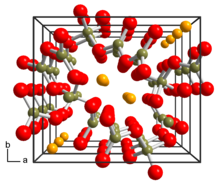Lithium triborate
 | |
| Identifiers | |
|---|---|
3D model (
JSmol ) |
|
PubChem CID
|
|
| |
| |
| Properties | |
| LiB3O5 | |
| Molar mass | 119.37 g·mol−1 |
| Appearance | Colorless crystalline solid |
| Density | 2.747 g/cm3 |
| Melting point | 834 °C (1,533 °F; 1,107 K) |
Refractive index (nD)
|
1.5656 |
| Structure | |
| Orthorhombic | |
Except where otherwise noted, data are given for materials in their standard state (at 25 °C [77 °F], 100 kPa).
| |
Lithium triborate (LiB3O5) or LBO is a
phase-matched. In the latter case the crystal has to be heated or cooled depending on the wavelength
.
Lithium triborate was discovered and developed by Chen Chuangtian and others of the Fujian Institute of Research on the Structure of Matter, Chinese Academy of Sciences. It has been patented.[1]
Chemical properties
- Point group: mm2
- Lattice parameters: a=8.4473 Å, b=7.3788 Å, c=5.1395 Å
- Mohs hardness: 6
- Transmission range: 0.16 – 2.6 μm
- Damage threshold: 25 J/cm2 (1064 nm, 10 ns pulses)
- Thermal expansion coefficients: x: 10.8×10−5/K, y: −8.8×10−5/K, z: 3.4×10−5/K
- Specific heat: 1060 J/kg·K
- Melting point: 834 °C
Applications of lithium triborate (LBO) crystal
Lithium triborate (LBO) crystals are applicable in various nonlinear optical applications:[2]
- Frequency doubling (SHG) and frequency tripling of high peak power pulsed Nd doped, Ti:Sapphire lasers and Dye lasers
- NCPM (non-critical phase matching for frequency conversion of CW and quasi CW radiation
- OPO (Optical parametric oscillator) of both Type 1 and Type 2 phase-matching
References
- ^ U.S. patent 4,826,283 (issued in 1989), 2023845 in Japan and CN88102084.2 in China.
- ^ LBO crystal applications at www.eksmaoptics.com
